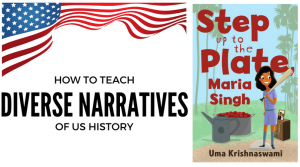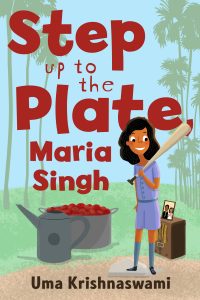In this guest post, educator and writer Tami Charles presents text- dependent questions and inquiry-based activities for students to practice close reading and critical thinking with the book Step Up to the Plate, Maria Singh.

As educators, we have the power to present a new history—one that is not abbreviated or cleaned up. We can model the genuine purpose of history curriculum by exposing our students to diverse narratives in a way that allows them to generate their own opinions and rationalize complex viewpoints. Armed with knowledge and critical thinking skills, students are better prepared to contribute to the future of these great United States of America.
Back in November 2016, I had the opportunity to write a blog post about forgotten narratives. Shame the Stars, by Guadalupe García McCall, was the focus of my report. The novel uncovers a period of violence toward Mexican-Americans in 1915, shortly after the Mexican Revolution. The lessons learned and knowledge gained were shocking, to say the least. Moreover, I was left with pressing concerns and questions:
Why didn’t I learn about this in school?
Why aren’t we teaching this segment of history today?
And what other narratives have been hidden from American history textbooks?
Enter Step Up to the Plate, Maria Singh, by Uma Krishnaswami—a middle grade historical novel, set in 1945, about a nine-year-old girl who longs to play softball. Such a classic American story—a girl with dreams of doing what is deemed taboo at the time. And even as Maria’s athletic dreams soar, she learns early on of the cruelties that exist in her world. Her parents—Papi from India and Mamá from Mexico—and many “half and half” families in Yuba City, California  are subjected to the discriminatory laws of the land:
are subjected to the discriminatory laws of the land:
- Immigrants from India are not allowed to become citizens of the United States.
- They cannot own land.
- Marrying outside of their race is illegal, though they skirt legislative constraints by listing their ethnicities as “brown.”
- All the while, Indian and other Asian immigrants willfully serve the United States in World War II, with no guarantee of full citizenship thereafter.
When Maria’s family is on the brink of losing their farm, the prejudices against her people seem to multiply and explode, leaving Maria with a hard decision: Can she step up to plate and find her voice in an unfair world? Young Maria must navigate her way through prejudice, while straddling the lines of her three cultures: Half Indian. Half Mexican. 100% American.
Step Up to the Plate, Maria Singh paints a picture of the life of many Asian and Hispanic immigrants in 1945. Here in America. Land of the free. Home of the brave.
It is a widespread belief that schools often teach only one side of American history. Books like Lies My Teacher Told Me by James Loewen point out the growing problems of history curriculum in schools: the “herofication” of historical figures like Christopher Columbus, the whitewashing and masking of important realities and injustices, and the deliberate exclusion of the major roles Native Americans, Latinos, African Americans, and Asians have played in the development of our country.
According to the National Council of Social Studies, “Our global community owes children opportunities to explore the variety and complexity of human experience through a dynamic and meaningful education.”
Books like Step Up to the Plate, Maria Singh are adding to the growing body of literature that addresses hidden narratives students should be learning. The Mexican-Indian experience in America is a relevant piece of history, especially since this biethnic community has dwindled in contemporary times. These are the histories that need to be taught along with such staple topics as the Civil Rights Movement and The Great Depression.
Reading Step up to the Plate, Maria Singh will encourage thought-provoking conversation in the classroom. As such, I invite educators to consider introducing this fun learning activity:
YOU be the host! Radio Broadcasts of 1945…
Objective: To review and demonstrate how radio was used as a medium of mass communication to inform listeners of important national and international events.
Anticipatory Set—Introduce the activity by using this graphic organizer:

Background knowledge—
Long before television and the internet, listening to the radio was a time when people from all walks of life gathered to hear important news, sports games, variety shows, and catchy tunes. By the 1940s, radio broadcasts would provide on-the-spot coverage of real battles happening in faraway lands. Most specifically, a December 7, 1941 announcement of the Pearl Harbor attack incited President Roosevelt to declare war a day later, in front of 60 million listeners. This ushered in World War II, often dubbed as the “radio war.” Radio played an integral role in creating a sense of national unity and allocating resources to help in the war effort.
Job opportunities for women that would have previously been forbidden, suddenly became available during the war. As young male athletes were drafted to fight in the war, minor league baseball teams began to disband. This ushered in the All-American Girls Baseball League and became a hit on radio broadcasts nationwide. Lastly, as shown in the novel, many Indian immigrants listened to the radio to stay informed about India’s independence movement against British rule.
Let’s use this background knowledge and the information from the anchor text to bring learning to life!
Materials:
- anchor text
- online supporting articles
- writing journals
- tape recorder
Learning Activity:
Students will write and produce their own radio show…for a real audience! Students will work in groups of 2–4. They will create a radio broadcast that covers one of the following topics presented in the novel:
- World War II
- India’s Fight for Freedom from the British
- Women in the Workplace
- Women on the Ball Field
- Pearl Harbor (bonus topic, if needed)
Students are encouraged to use direct quotes (and information) from the text, in addition to online sources that support their broadcast topic. Students will work together to research and write the scripts in their journals, and record their show using a tape player. Final broadcasts will be shared with the class and parents.
Common Core Standards Addressed:
CCSS.ELA-LITERACY.RI.4.3, CCSS.ELA-LITERACY.RI.4.6, CCSS.ELA-LITERACY.RI.4.9, CCSS.ELA-LITERACY.SL.4.2, CCSS.ELA-LITERACY.SL.4.5, CCSS.ELA-LITERACY.SL.4.4, CCSS.ELA-LITERACY.W.4.3, CCSS.ELA-LITERACY.W.4.7
 About the author: For fourteen years, Tami Charles served as a public school educator but now writes full time. Her middle grade novel, Like Vanessa, debuts with Charlesbridge in spring 2018. She is represented by Lara Perkins of the Andrea Brown Literary Agency.
About the author: For fourteen years, Tami Charles served as a public school educator but now writes full time. Her middle grade novel, Like Vanessa, debuts with Charlesbridge in spring 2018. She is represented by Lara Perkins of the Andrea Brown Literary Agency.








